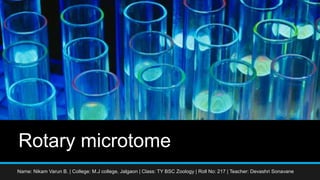
Rotary microtome seminar.pptx
- 1. Rotary microtome Name: Nikam Varun B. | College: M.J college, Jalgaon | Class: TY BSC Zoology | Roll No: 217 | Teacher: Devashri Sonavane
- 2. Introduction: • Many living things are extraordinary beautiful. The microscopist has a privilege view and this may be an extended and enhanced by looking inside; This can be done by making a very thin sections of it. It means the tissue can be sectioned and attached to a surface for further microscopic examination. • Microtomy means by which tissue can be sectioned and attached to a surface for further microscopic examination.
- 3. Seminar Overview • What are types of microtome? • What is rotary microtome? • What is the principle of microtome? • What is the importance of microtome? • What are uses of microtome? • What are advantages of microtome?
- 4. What are the types of microtomes in our syllabus? Rocking microtome. Rotary microtome.
- 5. What is the rotary microtome? • A microtome in which the object to be cut moves vertically downward against the knife while the wheel action is translated into a back-and-forth movement and specimen is being sectioned. • It is derived from the Greek Mikros, meaning “small, and temnein, meaning “to cut”) • It’s a mechanical device used for cutting uniform slices of tissue sections.
- 6. What is the principle of rotary microtome? • A Rotary microtome is worked by rotating a wheel fitted with a handle. The razor is placed in front of the microtome in a razor- holder which is movable. The material, embedded in a paraffin block, is fixed on the block-holder which can be fixed to an adjustable socket.
- 7. What is the importance of rotary microtome (or any microtome)? • Its importance in science: Microtomes are used in microscopy, allowing for the preparation of samples for observation under transmitted light or electron radiation. Microtomes helps us in giving desirable sections of any μm we desire also it provides section trimming and cutting features of any μm and we get our thin section which helps us in identifying the tissue and its parts. • It is also known as semi-automated rotary microtome.
- 8. What are the advantages of rotary microtome? • A microtome is used to make thin slices of tissue (usually 4 μm but can be 2–10 μm). • It is heavier, so more stable while rotating. • Large and heavier knife used-less vibration when cutting hard tissue. • Cutting angle of knife is easy adjustable. • Easy adaption of any type of tissue like hard, fragile or fatty. • Ideal for cutting serial sections: Large number of sections from each block. • It has safety lock helps in blocking the handle.
- 9. Conclusion • It is really an important apparatus in microtechnique. • Also maintenance is high since it’s has rotary mechanics.
- 10. Works Cited • A History of Microtechnique: The Evolution of the Microtome and the Development of Tissue Preparations. • Microtomes and microtome knives (from researchgate authors: Faraz Mohammed and Shamaz Mohamed.
Notas do Editor
- Summarize your research in three to five points.